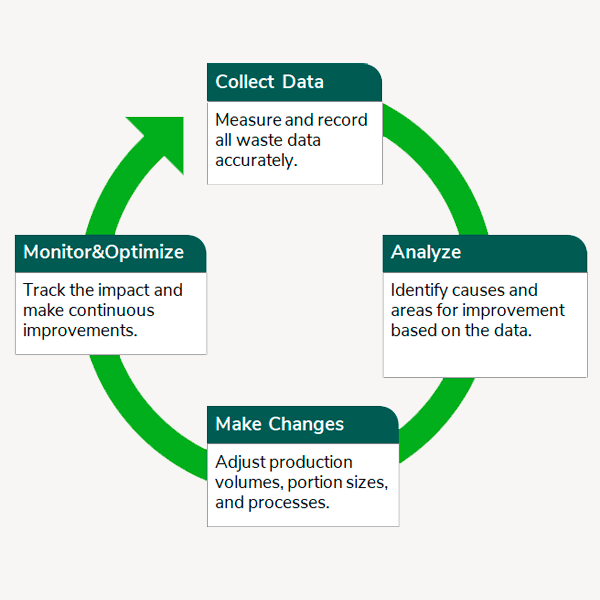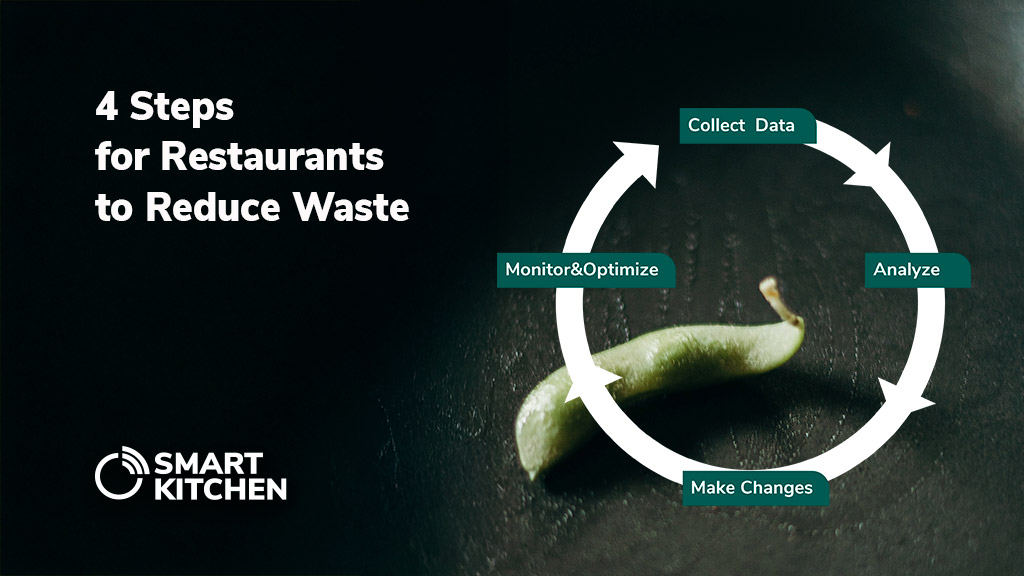Reducing food waste is one of the biggest challenges for restaurants, but it also presents a significant opportunity to cut costs and promote sustainability. Food waste is not just food thrown away – it’s wasted money, resources, and environmental impact.
Food waste reduction is not an overnight success story; it’s an ongoing process that requires consistent effort and attention to detail. At SmartKitchen, we often emphasize that the journey toward less waste begins with one crucial step: accurate data collection. Without a clear picture of where and how waste is generated, it’s impossible to make meaningful changes.
A Continuous Process:
4 Steps for Restaurants to Reduce Food Waste
Step 1: Collecting Accurate Data
The first step in any food waste reduction effort is collecting comprehensive and accurate data. SmartKitchen’s waste scale system helps automate this process, ensuring that all waste is accounted for, leaving no room for error that might occur in manual recording. This provides kitchens with a reliable starting point to begin their reduction efforts.
In fact, during the first year of monitoring, the amount of food waste may even increase. This doesn’t mean that waste has increased – it simply indicates that now all waste is being measured. The full scope of waste becomes visible when using automated tools like SmartKitchen’s waste scales.
Step 2: Analyzing the Data
Once you have the data, the next phase is analysis. This is where key insights are drawn: identifying patterns in production, plate waste, and storage losses. By understanding where the largest amounts of waste come from, kitchens can target specific areas for improvement.
Analysis should lead to adjustments in production volumes, modifications to menus, or tweaks to portion sizes – all aimed at reducing unnecessary waste.
Step 3: Implementing Changes
Based on the analysis, changes are made. For example, a kitchen may decide to reduce production during specific meal services where waste tends to be higher, or they might alter portion sizes. These changes don’t always need to be drastic. Even small, incremental adjustments can yield significant savings over time – in both financial terms and environmental impact.
Step 4: Monitoring the Impact
After implementing changes, it’s essential to monitor the results. Are the waste levels decreasing? Are the savings in line with expectations? Are there any unintended consequences? This stage is about following up on the changes and ensuring they are sustainable. At SmartKitchen, our systems allow for continuous tracking, providing detailed reports on the financial and environmental benefits of the changes made.
A Continuous Loop of Improvement
The process of food waste reduction doesn’t stop after one round of changes. In fact, it’s a continuous cycle: data collection, analysis, adjustment, and monitoring. Each phase feeds into the next, creating a loop of ongoing improvement. Over time, kitchens can focus on ensuring that the improvements they make are sustainable and continue to evolve.
It’s important to remember that 50% reductions aren’t always possible across the board. Instead, the goal should be to identify the biggest opportunities for improvement, make those changes permanent, and continuously find new ways to improve.

A Unified Approach to Waste Reduction
At SmartKitchen, we believe that guiding and leading the way in food waste reduction requires a unified approach. Sharing best practices and standardizing processes across the kitchen helps ensure that everyone is working toward the same goal. Our waste monitoring tools, and self-monitoring system provide the essential data needed to fuel these improvements, enabling kitchen teams to make informed decisions that lead to lasting change.
The journey to reducing food waste is a marathon, not a sprint. By focusing on data, making targeted changes, and fostering a culture of continuous improvement, kitchens can make a meaningful impact—not only in reducing waste but also in achieving long-term sustainability goals.
